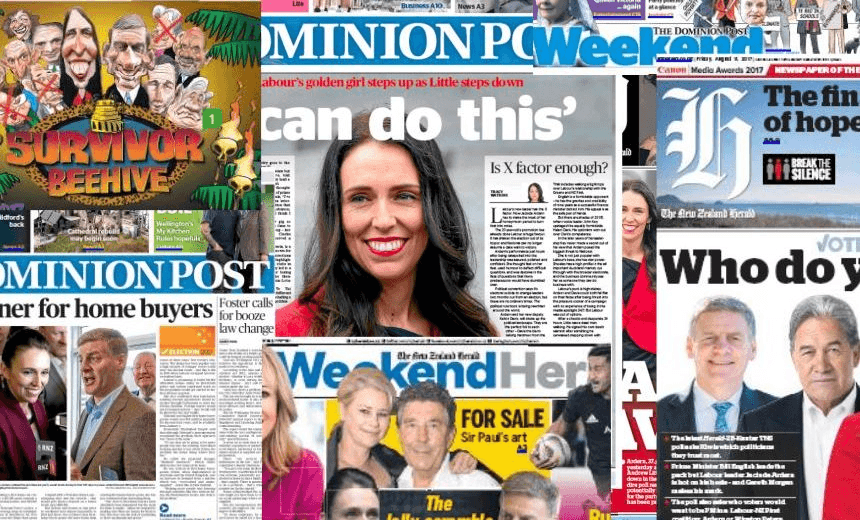In 2011 and 2014, the National Party leader was pictured considerably more frequently and prominently in newspapers. This year, Claire Robinson, professor of communication design at Massey University, is repeating her study and brings an interim report.
At great risk to my own sense of worth I have studied visual image bias in the New Zealand press since 2011. I say at great risk because I have copped a horrendous amount of abuse over the years, on social media and from very senior members of the news media itself, for my findings that there was a bias, albeit structural, towards John Key’s image in the 2011 and 2014 press campaign coverage. The press likes to think of itself as objective, fair and balanced. And this may be so when it comes to balance in words and column centimetres. But what I discovered in 2011 and 2014 was a large discrepancy between the number of images of Phil Goff, David Cunliffe and John Key in New Zealand newspapers, with John Key the major benefactor in both elections.
Why is it important whether there are more images of one party leader than another? It’s because of the “mere exposure” psychological effect, by which people’s preference for a stimulus is increased by repeated exposure to it. In other words, the more familiar you are with someone’s image, the more you feel an affinity for that person, the more you are likely to feel comfortable voting for them, whether you are consciously aware of it or not. The obverse is also true: parties and candidates who are invisible in the news are out of sight and not top of mind when voters are making decisions and consequently at a distinct disadvantage. Ensuring their party leaders get as much visual coverage as possible is therefore the goal for most party campaign strategists.
And herein lies the issue. If, by the image selections and omissions they make, the press effectively supports the electoral fortunes of candidates who are most successful at getting their picture in the paper, we have reason to question the ability of voters to make well informed and objective voting choices, the ability of political parties and candidates to participate in a genuinely fair contest in which all have the opportunity to be seen and heard, and the independence of the press from political power. A lot is at stake.
How’s it all going this year, now that John Key is no longer in the picture?
Let’s first look back to what we are comparing this year’s image coverage with. In 2011 I studied the major party leader image coverage in the Dominion Post, Sunday Star Times, New Zealand Herald, Weekend Herald and Herald on Sunday over the period of the election campaign. Of a total of 218 images, 63% were of John Key and 70% of the front-page images featuring a major party leader were of Key. In 2014 I expanded the study to include the Press and the Southland Times to ensure greater geographic coverage across the country. Things didn’t change much. Of the 268 major leader images studied in the campaign period 66% were of Key and he got 66% of the front-page coverage.
This year I have changed it a little. I’ve looked at press image coverage of Jacinda Ardern and Bill English in two periods: for the two week period 5-20 August starting not long after Ardern became leader, and the last three weeks of the campaign, from 4-22 September. And I’m only looking at the newspapers I looked at in the 2011 study, because they turned out to be adequately representative of the whole country.
In the period 5-20 August there were 94 images of the two major party leaders. English featured in 23 images (24.5%), Ardern featured in 71 (75.5%). English featured in 13.3% of front-page images to Adern’s 86.6%. It’s quite a discrepancy but it’s also understandable. New Zealand deserved to know more about the new history-defying leader of the Labour party.
So what of the next period? Obviously with five days to go the campaign isn’t over yet, but things are looking much more equitable. Between 4 and 17 September there have been 111 images published in the newspapers. Fifty (45%) of them are of Bill English, 61 (55%) of Jacinda Ardern. While she still has a small advantage, when it comes to front page images they are on an even playing field, both having 10 (50%).
My ego would like to think that my earlier research may have raised editorial awareness of the need for greater image balance in newspaper coverage of party leaders and a change of editorial perspective. However, the balanced picture is more likely to be a result of the closeness of this particular contest and the absence of an incumbent leader. Nonetheless, there is reason to be grateful. Readers, voters and MMP are much better served by fairness and balance in press image coverage. Let’s hope it lasts for the rest of this last week.
The Spinoff Media is sponsored by MBM, an award-winning strategic media agency specialising in digital, with vast experience across all channels. We deliver smart, tailored media solutions as well as offering a leading data and analytics consultancy. Talk to us about your communications challenges and how MBM can help bring you success through the power of media and technology.

